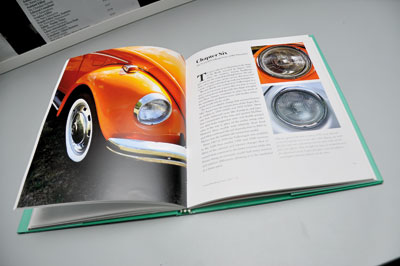Bitten and smitten by the Beetle bug
A doctor, a Beetle and an unlikely love-story in print!

Prof. Arjuna Medagama
It is as ‘Bumble Bee’, the popular Transformer which takes on the persona of the yellow Volkswagen (VW) Beetle which is doing the cinematic rounds that ‘A visual, technical guide & a lifetime of association’ with this very same vehicle came to my desk the other day.
As I flicked through the pages, intricate details and everything anyone needs to know about the Volkswagen Beetle popped up from Prof. Arjuna Medagama, a medical specialist and Professor of the Faculty of Medicine, University of Peradeniya.
Gripped by an early interest in the railways and automobiles, what has caught and held his fascination has been the Volkswagen in general and the Beetle in particular taking him down the pathway of restoring many of these beloved vehicles to near-perfection.
However, he is not selfish, wanting to keep his love to himself but hopes that through this volume packed tight with charming photographs in all their different colours, be it orange, red, black, white, light green, light blue or metallic silver, and intricate details, he can spread the word and get more into the embrace of the Beetle.
Interestingly, the book also deals with a little bit of history, how back in 1934, Germany’s dictatorial Fuhrer Adolf Hitler commissioned Master Engineer Ferdinand Porsche to develop a “people’s car” – a family saloon for four.
The civilian manufacture of the Beetle came about only after the defeat of Germany in World War II in 1945, with more than 10,000 rolling off the production line by the end of 1946. Hitting its pinnacle of popularity in the 1950s and ’60s, its sales had then topped over a million a year.
More modern designs of other vehicles though wreaked havoc with the VW Beetle and the last German Beetle had come off the assembly line in 1978 at Emden. The global production ground to a halt only in 2003 at Puebla Mexico, after the manufacture of more than 21 million Beetles.
 Prof. Medagama who “before I could walk or run” began a life-long romance with the Beetle from his childhood had been propelled in the direction of this beauty as his father had owned several of them. He picks as his favourite the 1956 EN4214 with a “doubtful pedigree” which had towel rail bumpers and late ’60s turn signals – lured and held transfixed by the ever-friendly smiling face, put-putting noise of the engine and the superb craftsmanship of the entire car!
Prof. Medagama who “before I could walk or run” began a life-long romance with the Beetle from his childhood had been propelled in the direction of this beauty as his father had owned several of them. He picks as his favourite the 1956 EN4214 with a “doubtful pedigree” which had towel rail bumpers and late ’60s turn signals – lured and held transfixed by the ever-friendly smiling face, put-putting noise of the engine and the superb craftsmanship of the entire car!
That was just one his family had for 18 years, but it is within different varieties of Beetles that he not only travelled but also marked the milestones in his life including learning the basics of driving.
And we get an insight into the Beetles of different vintages, with each chapter dealing in-depth with the metamorphosis — additions and revisions of the body exterior, interior, under bonnet and interspersed technical information.
The ‘Contents’ page in itself is an eye-opener – becoming a tantalizing teaser nudging the reader forward with ‘The Splits & Ovals’; ‘The Early Big Window Years’; ‘The Last Sloping Headlamp Years’; ‘The Vertical Headlamp Years’; ‘The Super Beetle’ and more.
With each page, anyone who was under the impression that the Beetle was just a rear-engined noisy contraption providing basic transport, slowly and surely comes to the realization like Beetle aficionados that it is the “sweetest” thing that man created.
It is not only the virtues of the Beetle that Prof. Medagama touches on but also little laughable nuggets – explaining how the veteran Beetle owner is often irritated by: “Is this a ‘kane mail’ model?
According to Prof. Medagama, this Sinhala term meaning “hair on the ear lobe” refers to the existence of ventilator ducts behind the rear quarter glasses, an addition in 1970.
All Beetles are air-cooled and rear-engined…..…..“The engine is of a flat-four horizontally opposed type, meaning the cylinders are horizontally placed rather than placed vertically of a conventional engine. The horizontally opposed bit means that 2 of the 4 cylinders lie to the left of the crank and 2 to the right,” he says going into specific details about his ‘lover’, having tenderly seen and touched its every contour, inside out.
More practical advice comes from him – the fan belt or the dynamo pulley belt is something that you must pay particular attention to. If the belt is loose it will slip and the fan will not turn, thereby robbing the engine of essential cooling air and overheating it……..Heating is the worst enemy of the Beetle engine, he diagnoses with clinical precision.
The reader also gets an introduction to the “splits” and “ovals”, of course, referring to the rear windows.
“Even the latest splits and ovals are now ageing cars and definitely over 60 years. The splits came to the end of production in March 1953 and ovals saw their demise in 1957, when the large rear-window Beetle was introduced for the 1958 model year.
In Sri Lankan terms, the splits were three digit EL registered cars and the ovals were EL, EN and mid-range 1 SRI cars.
Over the years, the lights have also gone through transition – the ‘heart’ lights from October 1952 to July 1955 for the non-US market, the ‘snowflake’ lights for those between July 1955 and May 1961 and finally, the lamps being placed two inches higher than usual on the rear fender to be visible to traffic following behind.
He picks up the ‘turn indicators’ a fascinating feature of the US-only (1955) and states that European cars and cars officially imported to Sri Lanka through the agent did not have illuminating turn signals atop the fenders or in the rear light clusters up to 1960. Instead these cars had a semaphore unit built in to the door pillar, which was electrically operated through a conventional turn switch on the left-hand side of the steering column. The semaphore unit is illuminated so that it can be seen in the dark……taking modern road users by surprise!
When buying a Beetle, he warns that people should beware of “bodged” restorations, while adding that rust is an enemy, zeroing in on the “nasty place” most vulnerable to it as the battery tray under area, under the rear seat.
For the test, Prof. Medagama suggests a quiet road with minimal traffic to hear noises you may otherwise miss on a busy road. “Does it get into each gear without grinding? Is the shifting between gears smooth? Shuddering would mean a worn pressure plate or even an uneven flywheel surface. Crunching of gears means there is internal wear in the gearbox and needs a specialist repair to put it right. A certain amount of whining from the gearbox is almost universal and as long as it is not too loud and the car does not jump out of gear, any gear is generally acceptable.”
Does the car drive in a straight-line or does it wander over the road? Does it pull to a side? There are several plausible causes, he says, giving clear tables of ‘Technical Specifications – Engine Codes and Chassis Dating’ for easy reference.
Tuned to every beat, whine and rumble – like the heartbeat, the pulse and the pressure, Prof. Medagama certainly has been bitten and smitten by the Beetle bug.
Once you take up the book, you will be too, even if only to admire this beauty through its information-packed leaves.
‘The Volkswagen Beetle – A visual, technical guide & a lifetime of association’ priced at Rs. 3,900 is available at all Vijitha Yapa and Sarasavi Bookshops.


